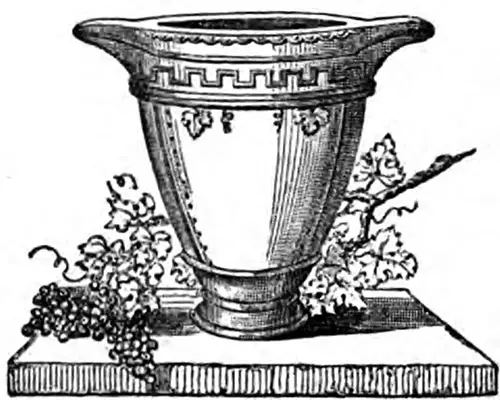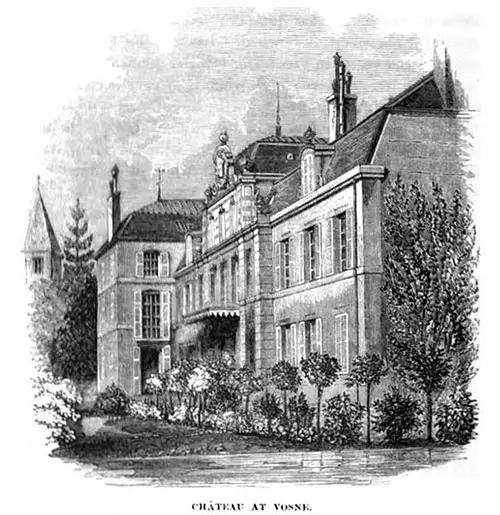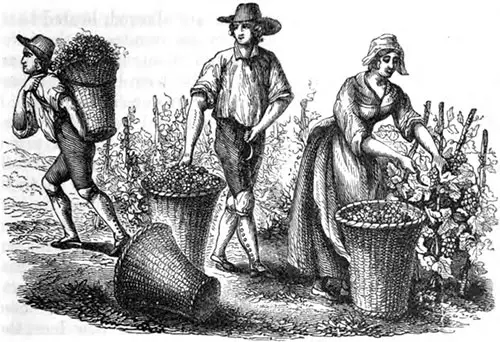Burgundy Wine District - 1862

Antique Wine Vase © 1860 Modern Cookery
The Burgundy wine was in ancient times considered the noblest and most generous of wines, except the Tokay; the wines from this district were often presented by the Princes of Burgundy to kings, princes, and chief nobles of foreign countries, as a great favor.
No banquet was given without the genuine Burgundy; even in the present age, this fine wine holds its own with connoisseurs and all lovers of a good glass. Industry and science have in modern times elevated the Bordeaux, and have made it a wine more generally used, on account of its mildness, as a table wine; but, nevertheless, the Burgundy is sought for by all nations, and the extensive district planted with its vines cannot supply the wants of the trade.
That portion of the district which produces the finest wines is called the Côte d'or, “Golden Hills.” This is a range of hills from Chalons sur Saone to Dijon, running from north-northeast to south-southwest, about eighty miles in length.
The height of these hills is from two hundred to three hundred feet, the soil is red and gravelly, containing a good deal of limestone, similar to our Sonoma soil, which also exists in almost every county in California by millions of acres.
These hills, with the exception of small spots where the red rock comes to the surface, are planted with vines, the vineyards reaching almost to the top of the hills.
The reason why they do not extend to the very crest is that no soil exists on the rocks toward the very top. The first quality of the wine is produced on the heights. The redder the soil, the better the wine.

Château at Vosne © 1964 Wine, the Vine, and the Cellar
The first-class vineyards plant exclusively the Pineau grapevines, a black grape with a small berry and a small bunch, which produces from a half to one and a half pounds to the vine. This gives the generous and widely famed Burgundy wine.
The second-class vineyards contain the Gamai grape, black in color, considerably larger as to berries than the Pineau, and more prolific, but giving an inferior wine.
The third class is at the foot of the hills, sometimes extending into the valleys. They are planted with Gamai and several other vines, producing blue and white grapes.
The various experiments made with the fresh-pressed juice from the Pineau showed ninety-six degrees of sugar and the greatest weight; while the Gamai, raised alongside, proved to be only eighty-four degrees.
In this province, when a vineyard is planted anew, the work is as follows: the ground is laid out with ditches five feet apart and one and a half feet deep; the ground is thrown between the ditches, making a ridge; the ditches are partially filled with good ground manure; the cuttings, eighteen inches long, are placed half a foot apart, bending toward the ridge; the soil is then drawn over the cutting and trampled down by the feet, leaving two buds out. The ridge is planted with potatoes, beans, beets, or cabbages.
The first and second year, during the summer, these vines receive two or three hoeings. The first year, these plantations do not receive any pruning but are left to grow as bushy as nature will allow.
The second year, in the spring, they are pruned to two buds, and more soil is drawn over, covering the plants up to the cut. Manure is also applied in the rows.
In the third year, the vines are pruned to two branches, each cut to two buds, and furnished with a stake from four to five feet long. During the fourth, or sometimes during the fifth year, small ditches are made from the vines toward the middle of the rows.
The vine then is drawn in this ditch, the root remaining, with one branch, in its original place. The other branch is bent to the center of the row, and two buds are left out of the ground.
The ridges which existed between the rows become, by this operation, leveled, and the whole vineyard now stands planted, two and a quarter foot apart, with vines. During the summer but one vine is allowed to grow up; all the other sprouts are rubbed off.
Many experiments were made by digging up the ground two feet deep, then taking an iron bar, and making a hole, and planting the cutting. This mode succeeded as well as that just described; that is, the vines grew and flourished well; but it was found that, after a certain number of years, the vineyards thus planted yielded but little; so that this mode is now abandoned, and the old ditching and laying system is now in use.
When the vines begin bearing, which is the fifth and sixth year, each retains but one stem, which is cut above the ground to three buds. This mode of cutting to three buds is repeated every year; that is, year after year the wood which possessed the three buds is left, and the new-made wood is cut to three buds.
Proceeding thus, in from eight to ten years the vine will be raised to the height of from two to three feet. It becomes, therefore, necessary to bring these vines nearer to the ground, and by this means to renovate and rejuvenate them.
This may be done in the following manner:
As soon as the vintner sees that a vine is growing too high, he will, in the month of February or March, dig a ditch a foot deep and six inches wide toward a vacant place, without any reference to the line.
The vine now is uncovered from the dirt on all sides and drawn into this ditch. The hole (or ditch) must be just as long as the old stem of the vine so that when laid horizontally the old stem will reach the end.
The yearling branch at the end of the old stem is then bent up, the ditch filled with manured soil, and the yearling branch cut to three buds above the ground. About one-tenth of the vines are annually so laid; consequently, every vineyard is renewed once in ten years.
By this operation, of course, all lines are destroyed, the vines standing every way like beans sowed broadcast; but, in as much as cultivation is carried on entirely by hand, it creates no inconvenience.
The vineyards are generally divided into ouvries (land of a day’s work). Such an ouvrie is 3645 square feet, in which ten to fifteen vines are to be laid every year by the hired vintner as a part of his regular duty, the payment being included in his wages; but if it should exceed the above number of vines, he is paid one sou for each extra vine.
The usual wages for working an acre for the year, excepting the packing of the grapes and making the wine is from eighty to a hundred francs per acre.
Many proprietors give their lands on half shares, as I have already mentioned.
The practice of manuring the vines is a necessary evil. It is a well-understood fact that vines produced on soil not manured will be more durable, and clearly better, and are, consequently, sooner ready for market.
The general conviction in this district is that the closer the bud to the main stem, the stronger the wine it will produce; that is, the first bud from the old wood will give grapes less in size than the second and third buds, but it will be a better wine.
It is also demonstrated that the top bud will produce wood which is much more prolific in bearing than the wood of either of the other buds.
The reader will understand that by cutting the vine to three buds, it will make, of course, three branch vines. The sprouts must be rubbed off, so that these three vines will grow vigorously, and enable the grapes to grow to perfection.
It is generally admitted by all the vintners and French writers that, the closer the vines are kept to the ground, the better the grapes will ripen, and they will contain more saccharine and coloring matter.
It is also agreed unanimously by all reports on this subject, that when vines are pruned for large crops many buds will be left on the vines, which will produce many grapes, but they will be neither as sweet nor as dark colored as the grapes from the moderate-bearing vines, besides making an inferior wine without the proper bouquet.
In the district of Burgundy, the practice of three-bud pruning is in general use. The vineyards being renewed every ten years, as described above, are, of course, kept in splendid condition.
We were told that the Burgundy vines exported to foreign countries, and not cultivated in the manner above described, in fifteen or twenty years ceases to bear entirely, or, if at all, in very small quantities.
The vintage is conducted as follows: Those proprietors of vineyards which have stone walls around them called “des Clos,” are allowed to gather their grapes whenever they please; consequently, they will begin the vintage whenever their grapes are in the very best condition.
This accounts for the fact that the wine from fenced vineyards is better in quality and commands a higher price in the wine market than that of others.
Those vineyards not fenced, and the largest portion, are subject to the following rules: Three commissioners on vineyards—one proprietor, one merchant, and one vintner—are appointed by the prefect, for the purpose of examining the vineyards from time to time, and reporting to the sub-prefect. When in their judgment the vineyards are fit for the vintage to begin, they report the fact.
At the receipt of this report, the sub-prefect issues his order, setting the day recommended by the commissioners for the work to begin. On this day everybody is compelled to commence the vintage; but, as their work is performed in a few days, the custom is to order a certain day in one village; in an adjacent one a few days later, and so on, so that sufficient hands can be procured to perform the necessary labor. If this were not done in districts where several hundred thousands of acres are planted with vines, it would be impossible to get the labor necessary, all at the required time.

Gathering the Grape © 1851 A History and Description of Modern Wine
The laboring men, women, and children, at such appointed-time, come from far and near, and collect at the market-place; here they are hired by the vintners, according to as they are needed. They are paid more or less, according to the number of laborers are greater or fewer. The gathering is described elsewhere.
The possessors of small vineyards usually sell their grapes to wine-dealers, who come to the vineyards. They either purchase by the measure or take the whole produce of the vineyard in a lump. The owner of the vineyard invariably has to gather and deliver the grapes to the purchaser and to pick and select them according to the desire of the merchant.
Those proprietors who have but small vineyards, and do not sell their grapes, but make them into wine, produce, without exception, an inferior quality; not on account of the locality or soil, but for the reason that they do not or cannot select their grapes, but throw all together, good and bad—the amount of grapes being too small to make different qualities of wine; the consequence is, that their wine brings indifferent prices.
It is believed, and we think with good reason, that the fewer the grapes on the vine the more perfect they will be and will receive from nature the full aroma natural to the species, and which makes the wine so celebrated for its bouquet.
A. Haraszthy, Excerpt from "The Burgundy Wine District," in Grape Culture, Wines, and Wine-Making: With Notes Upon Agriculture and Horticulture, New York: Harper & Brothers, 1862.
